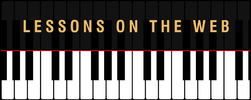|
You may not have heard the term Lead Sheet Symbols before now, but I bet you have seen the notations in your music without realizing it especially if you have tried playing any piece that isn’t classical. Lead sheet symbols are frequently found in jazz, pop, and blues music and they tell us what chord is to be played with the left hand so the actual notes/chords don’t have to be written out. It’s a bit like shorthand for writing music. It’s important then to be able to identify the chords noted and know how to play them easily. If you need a quick review on chords before going further, check out the info and video in this blog and then continue on below. Today we are going to be dealing first with triads, or chords with 3 notes in them. The most commonly used chords in most piano music are major, minor, augmented and diminished chords. These different types of chords are notated uniquely in lead sheets.
An easy way to remember these is to always know that major and augmented chords are indicated with capital letters and minor and diminished chords are always indicated with small letters. Augmented chords have a + by the note name, and diminished chords have a small circle next to the note name. The next type of chord that we’re going to learn about in lead sheets is the 7 chord. Before, we were talking about triads and all of the chords that you would build upon the lead sheet notations were 3-note chords. Now, we’re dealing with chords that contain 7 notes in them. They are still played with your left hand. Just as with our triads, 7 chords are indicated differently in sheet music.
Another type of chord that you may not have heard of is a Suspended chord. This chord is notated in lead sheets with the name of the chord along with “sus” next to it. For example, a C major suspended chord would look like “C sus”, along with a 4 or a 2 next to that – “C sus4”. Add chords are another chord that isn’t seen that frequently. If you see a chord name with “add2” next to it, or it can have any number next to it. Lead sheet symbols can also tell us which inversion of a chord we are to play with our left hands. Inversions will usually be notated by a slash to the right of the chord name and the name of the note used for the inversion. For example, if you have a C major chord indicated by a “C”, the 2nd inversion of this chord would look like “C/G”, and this tells you to start the C major chord on the 2nd inversion, or the note G. Most lead sheet music has only the melody line, or the right hand written out. The left hand notes are indicated by these notations we’ve gone over here today. The more you learn each of these notations and what types of chords they represent, you’ll be amazed at how many more types of music you’ll be able to quickly sight read through. This video goes over each of these symbols – showing what they look like in piano music and how to play each of these chords. It will definitely help you understand the harder chord types and it really helps to hear what they sound like on the piano. If you like my tips and lessons, you will love the courses over on my website. Whether you are a beginner looking to get a solid foundation to build on or you are looking to take your existing skills to that next level, the online music courses on my website https://www.pianolessonsontheweb.com will help you do just that. |
AuthorMost blogs written by Archives
June 2020
Categories
All
|

 RSS Feed
RSS Feed